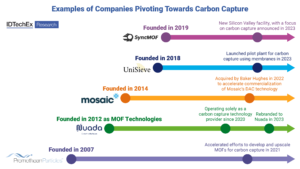“Interwoven Innovations: Quantum Technologies, MOFs, and Graphene Forge the Future of Smart Textiles”
Welcome fellow fabricates! Today, we embark on a fascinating journey through the realms of Printed Electronics World, brought to us by the brilliant minds at IDTechEx. There’s no denying it, the landscape of printed electronics is as vast and varied as the textile industry itself, and perhaps for a tech-enthusiast like you and me, that’s what makes it so exhilarating! From quantum technologies driving future mobility to the transformative power of metal-organic frameworks, let’s spool through this intricate tapestry of threads together.

The Quantum Leap in Future Mobility
Let’s start our adventure by stepping into the electrifying world of future mobility. The buzzwords here are electric, autonomous, interconnected—and it’s simply electric, folks! The synergy of these elements is crafting an automotive revolution, shifting gears towards ultra-modern transportation. Quantum technologies are setting the campaign trail ablaze with unprecedented potential, promising to disrupt traditional mobility with their incredibly sophisticated problem-solving capabilities.
Quantum technologies use the principles of quantum mechanics to perform computations at speeds and complexities far beyond the reach of classical computers. In the realm of textiles, imagine sensors powered by quantum technologies embedded into the very fibers of our seat belts and airbags, ensuring quicker reaction times and enhanced safety features.
The Secret Power of Thermal Interface Materials (TIMs)
Moving to another hot spot—let’s untangle the mysteries of thermal interface materials (TIMs). These materials are crucial in electronics for managing heat, ensuring the optimal performance and longevity of devices. TIMs are composed of thermal fillers and matrix materials; thermal fillers facilitate heat conduction, while matrix materials enhance mechanical properties.
When integrating heat-sensitive elements in technical textiles, such as wearable electronics, TIMs play a pivotal role in ensuring that the electronic components don’t overheat. It’s akin to the coolant in your car’s engine, ensuring everything runs smoothly and efficiently.
Magic of Metal-Organic Frameworks (MOFs)
Next, let’s weave through the marvels of Metal-Organic Frameworks (MOFs). Known for their design flexibility, structural versatility, and high porosity, MOFs are creating waves across multiple industries including textiles. From water harvesting in HVAC to direct lithium extraction, MOFs’ applications are vast.
MOFs can be incorporated into smart textiles to create garments that purify air, absorb harmful chemicals, or even capture CO2, making our clothes not just fabric but functional pieces of technology aimed at sustainability and improved quality of life.
Mesmerizing Metalenses
Brace yourself as we dive into the innovation of metalenses. Imagine lenses more sophisticated and far smaller than anything we’ve experienced before—metalenses could revolutionize computer vision, packing powerful capabilities into minimal space.
These ultra-thin lenses crafted from nanostructures can be integrated into textiles to provide enhanced visual capabilities in wearable tech, from medical diagnostics to augmented reality devices, making our clothes smart and perceptive.
Conductive Inks: The Backbone of Printed Electronics
Our next stop is the expansive world of conductive inks. This market is like a vibrant palette for artists, fundamental to printed electronics. Conductive inks can be applied to various surfaces and transformed into circuits, creating innumerable applications from photovoltaic cells to RFID tags.
Silver flake-based conductive inks are currently dominant, with emerging interest in non-silver variants such as stretchable and thermoformable inks. These inks can be seamlessly integrated into smart textiles, allowing for flexible, washable, and wearable tech—imagine gym wear that monitors your heart rate and sends data in real-time!
Quantum Dots Taking Displays to New Heights
In the pixel-perfect universe of displays, quantum dots are making quantum leaps. Quantum dots are semiconductor nanocrystals that shine with precision, creating more vibrant and energy-efficient displays.
When woven into textiles, quantum dots could lead to innovations in dynamic, luminous fabrics that change color or display patterns, making your fashion statement not just stylish but interactive and responsive.
Metamaterials and Electromagnetics: The Future Fabric
Let’s not forget the futuristic marvels of electromagnetic metamaterials. These materials have unique properties that can bend, absorb, or transmit electromagnetic waves in transformative ways. Their applications in optics and telecommunications hold promise for making biometric recognition more precise, enhancing virtual reality, and ensuring zero signal blackspots in mobile networks.
In textiles, metamaterials could be used to enhance the functionality of fabrics, creating wearable tech that can communicate seamlessly with smart devices, or even clothing that can shield us from harmful radiation.
Sustainable Solutions: Pyrolysis, Chemical Recycling, and PFAS
Sustainability is the cornerstone of modern innovation. Pyrolysis, a chemical recycling process, offers a novel solution to the plastic waste crisis, converting waste into valuable resources. As textile enthusiasts, we know that reducing waste in fashion is critical, and these technologies can lead to a more circular economy.
Chemical recycling and PFAS are integral elements in creating sustainable packaging solutions. These processes ensure that textile packaging remains eco-friendly, reducing the environmental footprint of our favorite brands.
Graphene: The Wonder Material Celebrates Two Decades
Graphene, first isolated in 2004, has been heralded as a wonder material with superlative properties. Celebrating its 20th anniversary, graphene continues to unlock new potentials in electronics, textiles, and beyond.
Graphene’s conductivity and strength make it ideal for smart textiles, enabling the creation of garments that are not only durable and lightweight but also embedded with sensors and conductive materials, truly bringing the future of fashion to our doorstep.
3D and Additive Electronics Innovating Automotive Industry
The integration of 3D and additive electronics is another game-changer, particularly in the automotive industry. By replacing traditional PCBs with printed electronics, we get sleek, integrated designs that save space and enhance functionality.
In textiles, this innovation means that electronics can be printed directly onto fabric, opening up endless possibilities for adaptive clothing, from temperature-regulating jackets to self-healing fabric.
Conclusion: The Interlaced Future
From quantum innovations charting the future of mobility to the endless applications of conductive inks and MOFs in textiles, IDTechEx’s insights paint a vivid picture of a technologically interwoven future. As textile tech aficionados, we stand at the edge of a new era where fabric and technology aren’t just threads in the loom but integral strands in a grand tapestry of innovation.
Smart textiles aren’t just a novelty; they’re becoming an integral part of the technological ecosystem, promising new levels of functionality and sustainability. With each advancement, from TIMs ensuring our devices stay cool to metalenses enhancing our vision, we see the fabric of technology and textiles getting tighter, stronger, and incredibly more fascinating.
So, whether it’s a quantum leap or a nano-sized thread, remember that every piece adds to the remarkable weave of our future. Stay tuned, stay curious, and let’s continue exploring the wondrous world of smart textiles together. Until next time, keep your fabric-tech dreams soaring! Adieu!
Keywords: Printed electronics, Quantum technologies, Metal-Organic Frameworks (MOFs), (Post number: 168), Smart textiles, Conductive inks





